Theoretical atomic astrophysics
The bulk of information about astrophysical objects such as stars or galaxies, or transient events such as supernovae, is carried to us by photons. Each element in the periodic table has its own unique spectral fingerprint, and so the light recorded by a spectrograph over a certain range of wavelengths thus depends on, and therefore uncovers, the fundamental composition of matter in the object under observation.
The intensity, wavelength and shape of spectral lines also tell us about other characteristics of the light source, such as temperatures, densities or the strengths and magnetic field properties. The science of light-matter interaction, and in particular the spectroscopic analysis of light, thus represents one of our most important scientific tools for studying nature. Atomic astrophysics can be viewed as the bridge between macroscopic astronomy and the microscopic world at the atomic and molecular level.
To derive accurate astrophysical properties from observed spectra, we need the best possible physics. This means precise descriptions of the microphysics, coupled with macroscopic models of the object under investigation. For these purposes, at Uppsala we work with fundamental atomic structure, radiative processes, as well as electron- and atom-atom collisions, through first-principles and semi-empirical quantum mechanical many-body methods. The microscopic data is then used as input to realistic astrophysical structure models in one or three dimensions and radiative transfer beyond the classical assumption of local thermodynamical equilibrium (LTE).
Relativistic atomic structure and the origin of heavy elements
The cosmic origin of elements beyond iron in the periodic table is a long-standing puzzle. One of the main astrophysical highlights of the last decade is thus without doubt the indication of rapid neutron-capture (r-process) nucleosynthesis of heavy elements in the supernovae-like aftermath following the neutron-star merger gravitational-wave event in mid 2017, termed a “kilonova”. The indications that the late-time light is dominated by high-opacity, r-process-element-rich ejecta introduces new demands on fundamental atomic data as input to the collisional-radiative spectral modelling, particularly of the infrared spectral region in largely uncharted territories of the periodic table.
The calculations of atomic data for heavy r-process elements does not come without computational challenges, such as complex energy level structures and important relativistic effects. Indeed, the impact of a relativistic quantum mechanical approach on an atomic system, as compared to classical non-relativistic quantum mechanics, become more and more profound the heavier the atomic system under investigation is, mostly due to the inner electrons approaching light speed. These relativistic effects can have big implications on the radiative properties of the atoms, and, therefore, we employ fully relativistic quantum mechanics to determine fundamental atomic data as input to the radiative transfer models used to synthesize spectra in the context of the r-process element production in neutron star mergers.
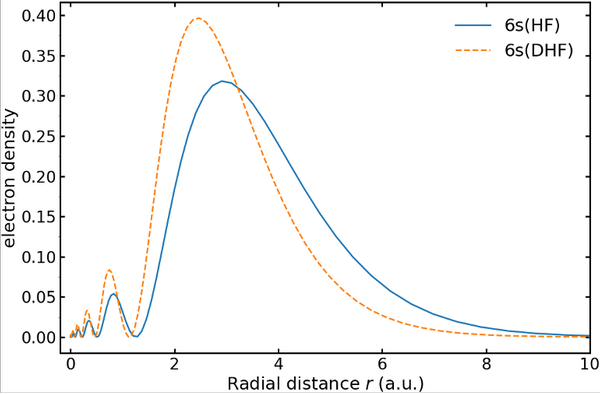
Comparison of the electron densities of the 6s valence orbital from the 5d106s ground configuration of neutral gold obtained using a non-relativistic (HF) calculation (blue solid) and a relativistic (DHF) calculation (orange dashed). Relativistic theory accurately predicts the valence electron to be bound by about 30% more energy than a corresponding non-relativistic model. Based on calculations presented in Caliskan, Grumer & Amarsi, 2024, Journal of Physics B, 57, 055003.
Inelastic collision processes and impact on spectra of cool stars
Collisional processes affect the populations of atomic levels, which in turn influence the strengths of spectral lines produced and therefore also the abundance of the element inferred from comparison of synthetic spectra with observations. Specifically we study electron-impact excitation and heavy particle collision processes, the latter mainly being hydrogen-impact excitation and charge transfer involving hydrogen.
The neglect of these processes can lead to large differences in measured abundances. In the cases of Li and Na, it has been found that the charge transfer processes alone can result in changes to derived abundances as large as 60%. In Mg, similarly large differences are found, and are a result of a combination of excitation and charge transfer processes. We test our calculations for charge transfer by comparison with experiments at the DESIREE facility in Stockholm.
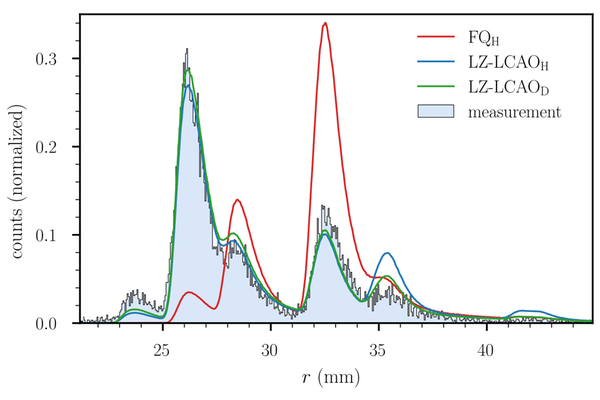
Experimental results and theoretical models for the distribution of particle separations in the mutual neutralization reaction Mg⁺ + D⁻ → Mg + D at a centre-of-mass energy E=59 meV. The theoretical LCAO model developed at Uppsala University (Barklem, 2016, Physical Review A, 93, 042705) gives an excellent fit to the experimental data from the DESIREE facility in Stockholm. From Grumer, Eklund, et al., 2022, Physical Review Letters, 128, 033401.
Collisional broadening of spectral lines
The strongest lines in stellar spectra are affected due to perturbations by nearby particles – so-called collisional broadening. These lines represent unique probes of various properties of stars, including temperature, pressure and chemical composition. The commonly used theory for collisional broadening (the Unsöld formula) gives values roughly half that needed to reproduce observed spectra. We mainly study the broadening of metal lines by hydrogen as well as self-broadening of hydrogen lines.
Based on comparisons to the Sun and standard stars, the uncertainty in our calculations is estimated in most cases at better than 10%. Calculations can be done for a wide range of spectral lines, and thus strong lines can now be used as spectral diagnostics in late-type stars with increased precision and confidence.
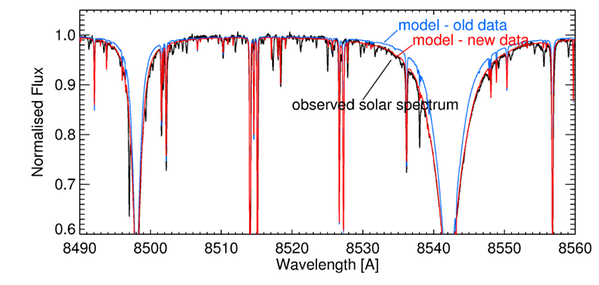
Two lines of calcium in the solar spectrum. Synthetic spectra with our data (full) and old data (dashed; Unsöld) for collisional broadening due to hydrogen, compared to observed spectra (double line, NSO Data). From Barklem, 2016, The Astronomy and Astrophysics Review, 24, 9.
Hyperfine and Zeeman effects in stellar spectra
In order to perform reliable spectral analysis, to determine e.g. element abundances, sometimes the physical conditions, or spectral resolution for that matter, are such that one has to include additional internal or external effects in the atomic model. One such case is the hyperfine interaction between the electrons and nuclei in isotopes with non-zero nuclear spin, which breaks the atomic symmetry and split spectral lines into multiple components and changes the line profiles from which the abundances are determined. Similarly, the presence of an external magnetic field, in e.g. a star, breaks the spherical atomic symmetry via directional quantization so that the magnetic sublevels become non-degenerate. Just like in the hyperfine case, this causes individual lines to be split into multiple components. In some cases both hyperfine and magnetic fields need to be considered simultaneously, which requires a systematic computational approach.
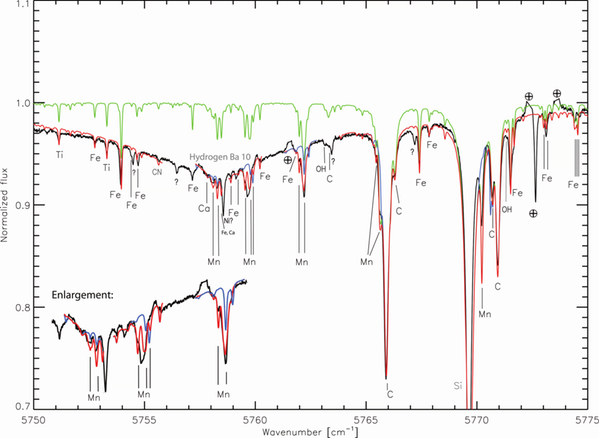
Synthetic spectra of the Sun determined from atomic data of manganese calculated using a detailed treatment of the hyperfine interaction including off-diagonal effects (red line) compared with the old synthetic model (blue line) and observations (black line). Although far from perfect, it is clear that the new model improves the agreement substantially and thus the inferred abundances. From Andersson, Grumer, et al., 2015, The Astrophysical Journal Supplementary Series, 216, 2.
Spectral line formation with 3D non-LTE models
The properties of stars can be inferred from their emitted light, by comparing their spectral absorption/emission lines against theoretical predictions. However, the overall accuracy obtainable is limited by the accuracy of these models. The vast majority of models in use today are hindered by two assumptions about stellar atmospheres: first that they are one-dimensional (1D) and hydrostatic; and secondly that they satisfy local thermodynamic equilibrium (LTE). Our group works on relaxing these assumptions: we develop the methods for, and carry out, non-LTE spectral line formation calculations in 3D stellar atmosphere simulations. These state-of-the-art models are subsequently compared to high-resolution spectroscopic observations so as to determine the properties and chemical compositions of stars such as our Sun to new levels of accuracy. This in turn sheds light on diverse areas of astrophysics, not least the physics of planet formation, the nature of the first stars, and the chemical evolution of our Galaxy.
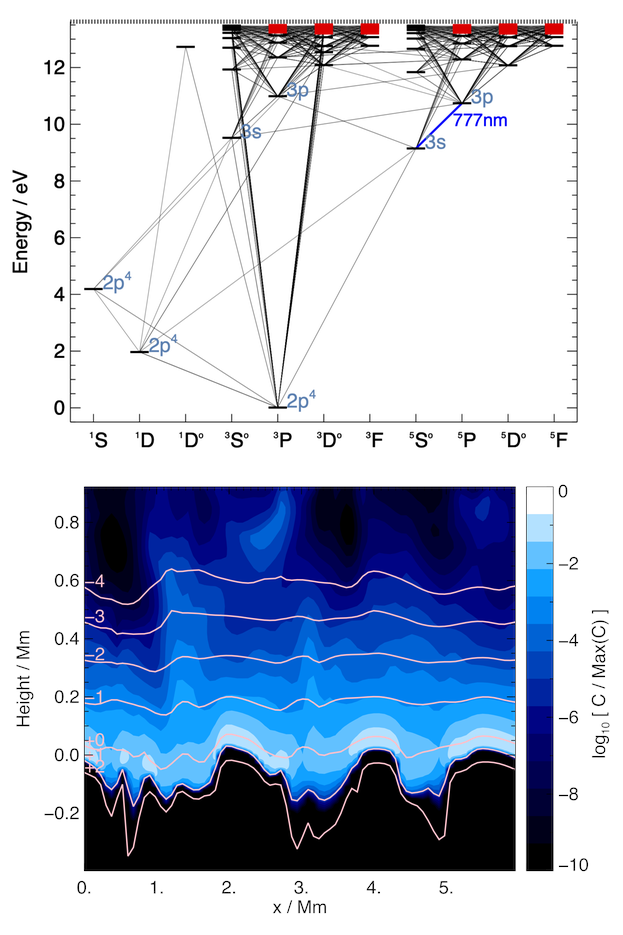
Top: Illustration of a comprehensive "model atom" for neutral oxygen, that describes the structure and radiative and collisional transitions, and is used when calculating the departures from Saha-Boltzmann equilibrium in stellar atmosphere. From Amarsi, Barklem, et al., 2018, Astronomy & Astrophysics, 616, 89. Bottom: Illustration of the formation regions of a line of neutral nitrogen, within a slice of a snapshot of a 3D radiative-hydrodynamic simulation of the solar atmosphere; contours of equal logarithmic optical depth are shown, delineating the stellar granulation. From Amarsi, Grevesse, et al., 2020, Astronomy & Astrophysics, 636, 120.
